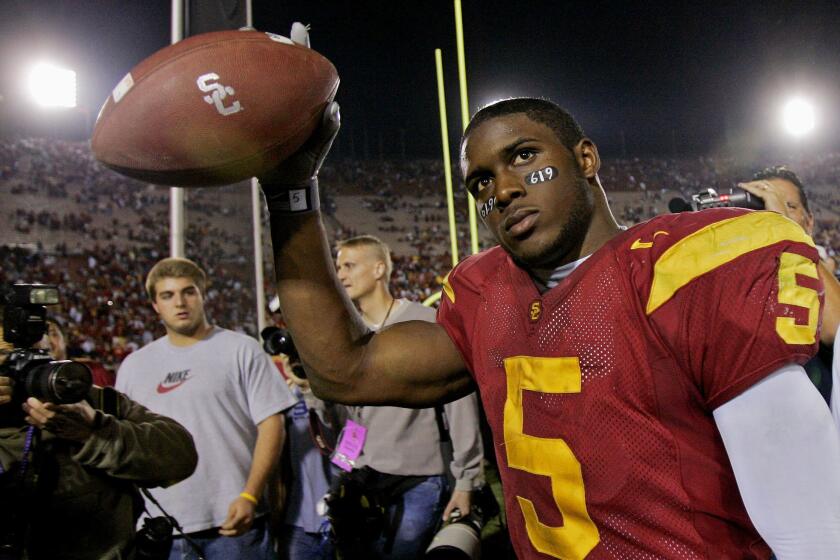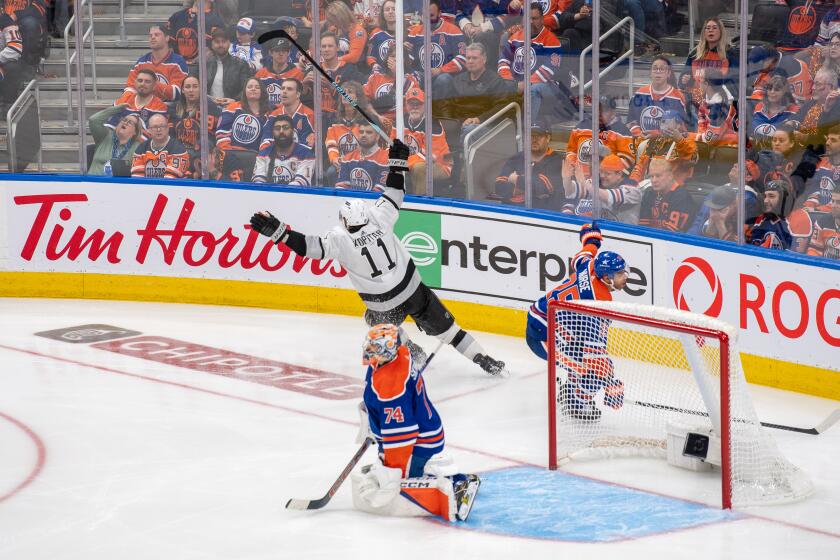NASCAR grapples with a downshift in popularity
First in a series
Is a sequel in store for Ricky Bobby?
NASCAR stock-car racing might well have reached its apex on a July night in 2006, not at a superspeedway but at Grauman’s Chinese Theatre in Hollywood.
It was the movie premiere of “Talladega Nights: The Ballad of Ricky Bobby,” a comedy producers had greenlighted after hearing a pitch of only six words: “Will Ferrell as a NASCAR driver.”
Hollywood loves the hottest trends, and few burned brighter then than NASCAR. The sport had found an extra gear of popularity with new fans and, as Ferrell’s movie proved, NASCAR simply seemed hip.
“Everybody thought this [surge] never could end,” said NASCAR team owner Rick Hendrick. “We were the hottest thing out there.”
Then, it wasn’t. Within a year after “Talladega Nights” premiered, there was a steady braking of NASCAR’s popularity. Race attendance and television viewership fell 15% to 20% from 2007 through 2010. Many corporate sponsors took their marketing dollars elsewhere and several race teams merged to survive.
The recession played the key role in slashing attendance and curbing sponsor spending, just as it hammered other sports. But the slumping TV ratings? That pointed directly at what NASCAR racing was offering, and many found it wanting — even at 200 mph — partly because of the sport’s self-inflicted missteps.
NASCAR still has a big following, but “all the fad people bailed,” said Peter De Lorenzo, who tracks NASCAR as editor of Autoextremist.com.
But as the sport’s premier Sprint Cup Series returns to Auto Club Speedway in Fontana this weekend for its fifth race of the season, there’s cautious optimism that the skid in NASCAR’s popularity has at least bottomed out.
NASCAR’s constituents, including track operators, team owners and sponsors, sense the strongest “buzz” in the sport in years, especially after 20-year-old Trevor Bayne captured the nation’s attention with his upset Daytona 500 win last month.
Most agree the racing is more compelling; four drivers won the first four races. NASCAR itself — the sanctioning body led by NASCAR Chairman Brian France and his family — gets applause for tweaking racing rules to help rekindle excitement, though it’s still criticized by some for a plodding response to the declines.
Cup races still typically draw 75,000 to 150,000 fans each week, depending on the track. Slightly more than 30 million people watched at least part of this year’s Daytona 500 on TV.
But NASCAR has a 10-month, 36-race season, and it’s too early to predict a rebound this year. The weak economy and soaring gasoline prices still weigh on attendance even if the recession is officially over. Sponsorships remain a tough sell.
Attendance through the first four races this season held steady with year-earlier levels and TV ratings rose about 10%, though ratings are basically flat compared with 2009.
At last Sunday’s race, NASCAR estimated there were 40,000 empty seats at the 160,000-seat Bristol (Tenn.) Motor Speedway, which for years was an automatic sellout.
“I watch [races] on TV still, but I don’t go to as many,” Keith Davis, a police officer in Live Oak, Fla., said while camped out in the track infield for the Daytona 500 last month. “It’s just the cost of it.”
Just as NASCAR’s decline dragged on for years, so its rebound will take time. “Would they love to see TV [ratings] go back up 20% this year? We all would,” said Joie Chitwood III, president of Daytona International Speedway. “That’s not realistic.”
Even NASCAR’s France cautioned this month that although NASCAR was “obviously pleased” with the year’s start, “no one around here is celebrating.”
Some predict NASCAR might never reach its former peak.
“I think we were on an artificial high” in 2005-07, Hendrick said. Now, NASCAR’s following probably has settled back to its core fan base and “there’s nothing wrong with that and we can grow from there,” he said.
How did NASCAR’s popularity lose traction and how can it rebound?
When “Talladega Nights” arrived, race attendance and NASCAR’s TV ratings had been climbing, boosted by a stronger economy and NASCAR’s expansion from its Southern roots to new markets such as Chicago, Kansas City, Las Vegas and Fort Worth.
Forbes magazine crowned it “America’s Fastest Growing Sport.” NASCAR signed an eight-year, $4.5-billion TV contract that was a whopping 40% richer than the previous one. Toyota was about to jump in as a maker of race cars for a piece of the action. Some tracks installed thousands of additional seats. The demographic term “NASCAR dad” was a catchphrase in politics.
But the growth stalled as the deep recession took hold. Track operators cut ticket prices to as low as $25 to blunt the impact, as swaths of empty grandstand seats from California to Georgia became glaring.
Attendance at Sprint Cup races last year was 3.6 million, down 16% from 2008, according to NASCAR’s estimates. But TV ratings also fell in that period and theories abounded as to why.
•The races, typically at three-plus hours, were too long for a nation with a seemingly shorter attention span and more technology choices, such as following races on the Internet.
•Jimmie Johnson, the Californian who has captured the Cup title the last five consecutive years, won too much.
•Dale Earnhardt Jr., the most popular driver, seldom won at all.
•NASCAR’s late-season playoff, the “Chase for the Cup,” lacked sufficient drama because its points system prompted drivers to focus more on consistent finishes than winning.
•Johnson and other drivers were bland personalities, and too many tracks looked alike. And there weren’t the headline-grabbing driver rivalries to draw casual fans.
But talk to people involved in NASCAR and most keep pointing back to one decisive culprit: The new race car that NASCAR mandated starting in 2007 in the Cup series turned off many drivers and fans.
NASCAR dubbed it the “Car of Tomorrow,” or COT. Designed mostly for enhanced driver safety following the 2001 death of seven-time champion Dale Earnhardt Sr., the car was unlike anything seen before.
It was boxy, had a rear wing and, even in a sport where cars had little resemblance to “stock” cars on the street, this one had almost no resemblance. Worse, the COT’s new chassis and steering system were temperamental to drive and hindered the passing that NASCAR fans crave.
After winning the first COT race, brash driver Kyle Busch told a national TV audience what many others in NASCAR garages were whispering. “I can’t stand to drive” the new car, Busch said as he stood in Victory Lane. “They suck.”
Suddenly, NASCAR had a big problem.
“If you look at something that hurt [the sport], that hurt. That car alienated a lot of fans,” said driver and team owner Michael Waltrip.
NASCAR also “thought the competition [on the track] would be good enough that it wouldn’t matter” what the car looked like, said Howard Comstock, Dodge’s engineering program manager for NASCAR. “It did matter, it mattered a lot to the fans.”
The car was part of “a disconnect” that opened between NASCAR and its fan base, agreed Julie Sobieski, a vice president at ESPN, which with its broadcast sister ABC splits the Cup series’ telecasts with Fox and TNT.
In retrospect, NASCAR President Mike Helton said, “If we had that opportunity to go back . . . we would probably introduce [the car] differently,” although he didn’t offer specifics.
Regardless of what NASCAR thought about the car, “the perception is that it was” a big factor in NASCAR’s popularity decline even if it kept drivers safer, he said.
Some also cite last year’s decision by Walt Disney Co. to shift most of its NASCAR telecasts from over-the-air ABC to cable’s ESPN as a contributor to the ratings drop.
John Saunders, president of International Speedway Corp., which operates 13 NASCAR tracks, said the switch lopped 15 million homes from potential viewership “right out of the gate.” NASCAR and ESPN expect the change to eventually pay off, especially among the 18-to-34 age group that they and advertisers covet.
And ESPN wasn’t solely the problem; ratings on Fox and TNT fell too.
Regardless, Helton rejected the notion that NASCAR had reached a peak that can never again be matched.
Even in the heady days when Ricky Bobby raced for laughs on movie screens nationwide, Helton said, “we never were happy with where we were.”
Next: How NASCAR hopes its popularity can gain speed again.
More to Read
Get our high school sports newsletter
Prep Rally is devoted to the SoCal high school sports experience, bringing you scores, stories and a behind-the-scenes look at what makes prep sports so popular.
You may occasionally receive promotional content from the Los Angeles Times.






